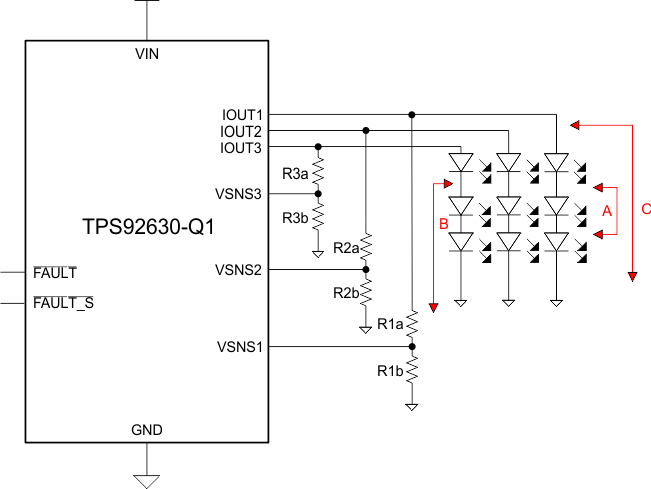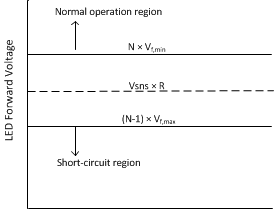SLVSC76E February 2014 – May 2018 TPS92630-Q1
PRODUCTION DATA.
- 1 Features
- 2 Applications
- 3 Description
- 4 Typical Application Schematic
- 5 Revision History
- 6 Description (Continued)
- 7 Pin Configuration and Functions
- 8 Specifications
- 9 Parameter Measurement Information
- 10Detailed Description
- 11Applications and Implementation
- 12Power Supply Recommendations
- 13Layout
- 14Device and Documentation Support
- 15Mechanical, Packaging, and Orderable Information
Package Options
Mechanical Data (Package|Pins)
- PWP|16
Thermal pad, mechanical data (Package|Pins)
- PWP|16
Orderable Information
10.3.4 Short-Circuit Detection
The device includes three internal comparators for LED forward-voltage measurement. With external resistor dividers, the device compares total LED forward voltage with the internal reference voltage. This feature enables the detection of one or more shorted LEDs. Any LED cathode or IOUTx pin shorted to ground results in a short-circuit condition. The external resistor dividers control the detection-threshold-voltage setting.
Figure 21 illustrates different short-circuit conditions.
 Figure 21. Short-Circuit Conditions
Figure 21. Short-Circuit Conditions
A short in one or more LEDs in a string (A and B as illustrated) registers as only a single-LED short when V(VIN) > 9 V.
- The device reports the failure to the MCU. The faulted channel continues sourcing current until the MCU takes actions to turn off channels through the EN or PWMx pin.
- No MCU: with FAULT_S floating, no action results. With FAULT_S tied to FAULT, all output channels shut down together.
When an entire string of LEDs is shorted (C as illustrated), the device pulls FAULT low to shut down all channels. With the FAULT pin tied high, only the faulted channel turns off.
- VF(max) – maximum forward voltage of LED used
- VF(min) – minimum forward voltage of LED used
- N – Number of LEDs used in a string
- R – resistor divider ratio
- V(VSNSx) – internal reference voltage of comparators
When selecting R, observe the following relationship to avoid false triggering.
 Figure 22. Single-LED Short-Trigger Calculation
Figure 22. Single-LED Short-Trigger Calculation